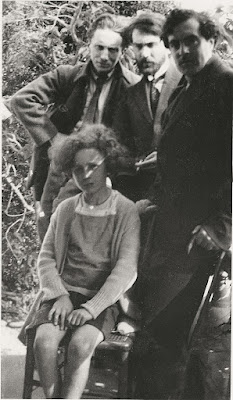CAPTURING THE MOMENT at the TATE MODERN on the 12th, June 2023
CAPTURING
THE MOMENT at the TATE MODERN on the 12th, June 2023
 |
| Bust de Femme by Pablo Picasso 1938, Yageo Foundation, Taiwan |
Capturing the Moment
is a deliberation on the inter-relationship between painting and photography
over the last 100 years or so. Of
course, photography was invented in the 19th century and the camera
had already been utilised by the Impressionists among others. They incorporated photographic techniques too
such as cropping, framing and, later, experimentalists developed techniques
like photomontage. The exhibition mentions
one of the pioneers of photography, Eadweard Muybridge (1830-1904) who also
influenced the British artist Francis Bacon (1909-1992), one of the artists
represented here. Muybridge was born in
London but lived in the US. He was a
pioneer of stop motion photography and was the first person to prove that a
galloping horse lifts its legs off the ground when it gallops. He also photographed athletes and boxers to
divide and dissect each movement and to observe via the photographic process,
the unobservable. The tiny movements the eye fails to register, the captive
moment.
.jpeg) |
| Dorothea Lange, Migrant Mother, Nipomo, California 1936 |
Capturing the Moment
begins, for the sake of convenience, with Picasso’s Cubist experiments
completed in the 1930s such as Weeping Woman (1937), a subject that also
came to summarise the Spanish Civil War. Although it is not stated explicitly, what is
at stake here is not the subject but the observer. The movement away from the notion of a
stable, omnipotent observer informed the art movements that were to dominate
Europe in the inter-war years. This is the
starting point of Capturing the Moment, and it moves onto examine the
work of artists like Gerhard Richter (1932- ) and Andy Warhol (1928-1987) who
questioned the dominant assumption regarding the veracity of photography.
 |
| Francis Bacon, Study for a Pope VI, 1961, Yageo Foundation Collection Taiwan |
The exhibition charts the
triumph of abstraction over realist painting as a necessary prelude to the
dominance of photography. Up until the
appearance of the camera, realism was the point of art. However, the development of the camera made
realism a redundant aesthetic. The point now was to push the horizon line above the edge of the canvas and depict abstraction.
 |
| Andreas Gursky, May Day IV 2000. Yageo Foundation Taiwan |
 |
| Cecily Brown, Trouble in Paradise, 1999, (c) Cecily Brown |
The usual themes of the environment, Gay whatever and the digital age are all discussed. The reliability and unreliability of memory and, by association, the veracity of the photographic image, are discussed in relation to artists like Gerhard Richter and Marlene Dumas (1953-). Dumas depicts feminist icons like Lucy (2004) and Stern (2004) which is an artwork based on the famous photograph in Stern magazine of Ulrike Meinhof, a journalist and member of the Red Army Faction or Baader-Meinhof Group (which was a media construction, Ulrike Meinhof was a journalist interested in the RAF who became a member by way of some supposed Stockholm syndrome. She was gaoled and died in gaol. The political establishment claimed that she committed suicide but many believed that she was murdered.). Much more contextualisation was required to understand the connection between the original image and its re-shaping by the artist. The viewer was left wondering why these paintings and photographs were being placed together except that they are rather attractive paintings and photographs and then there is the necessity to engage with something.
 |
| Gerhard Richter, Two Candles, 1982 |
Although rather short of the usual Tate Modern expectations, Capturing the Moment is still informative, engaged and is certainly a great introduction to some of the issues concerning painting and photography.


Comments